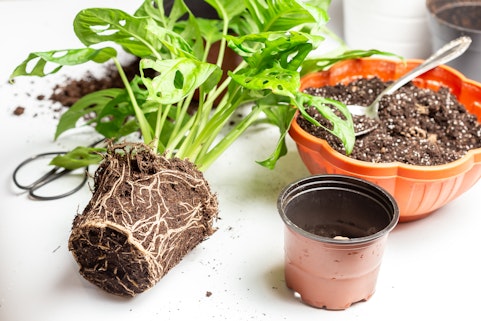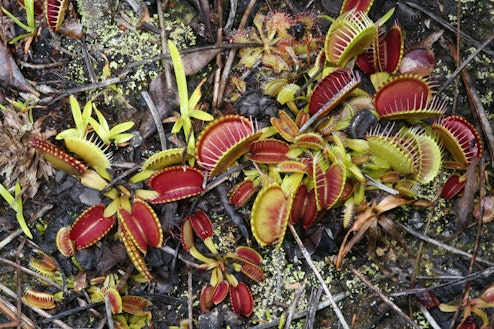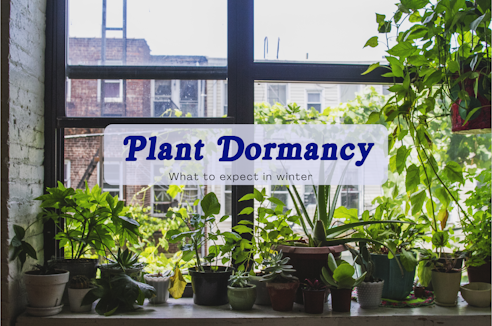
- Home
- Understanding Light

Plants eat light. Isn’t that just crazy? Imagine going to a restaurant and ordering a plate of light with a side of carbon dioxide, because that’s what your plants are eating every day, although this is a very dramatic simplification. Through photosynthesis, plants are able to capture light energy and use it to convert water, carbon dioxide and various chemicals like phosphorus, nitrogen and potassium into organic compounds to grow and reproduce. It goes without saying then, that without light your houseplants would greatly suffer.
How do I know if my plant is getting enough light?
Generally speaking, a healthy looking plant is getting enough light. So if you don’t suspect your plant is unwell, then it's unlikely you have a light problem! However, there are a few things to keep an eye out for. If a plant is starved for light it can wither away slowly and subtly, so it is best to have an idea of what a light-starved plant looks like:
- Discolouration: Plants that haven’t enough light often discolour. Look for white, light green, yellow or brown leaves on the side of the plant that is farthest from the source of light, this could be an indicator that it needs more.
- Etiolation: This is where a plant’s growth is thin and leggy. It will grow long, pale stems and small leaves that are spaced far apart.
- Phototropism: This is where a plant grows dramatically towards a light source. If your plant is pushing itself to get closer to the source of light, then it requires more!
- Lack of growth: As their main source of energy, light helps plants complete the processes required to grow and bloom. Without adequate light, a plant may stop growing altogether and use what little energy it has to stay alive.
- Not taking up water: Taking up water requires energy, which a plant receives from light. Without sufficient energy, a plant will take up water slowly, leaving it more prone to root rot and other related problems.
- Pests: Although a lack of adequate light does not cause pests directly, they do leave a plant more vulnerable to them. If you’re wondering why some of your plants suffer from pest trouble while others do, this might be the answer!
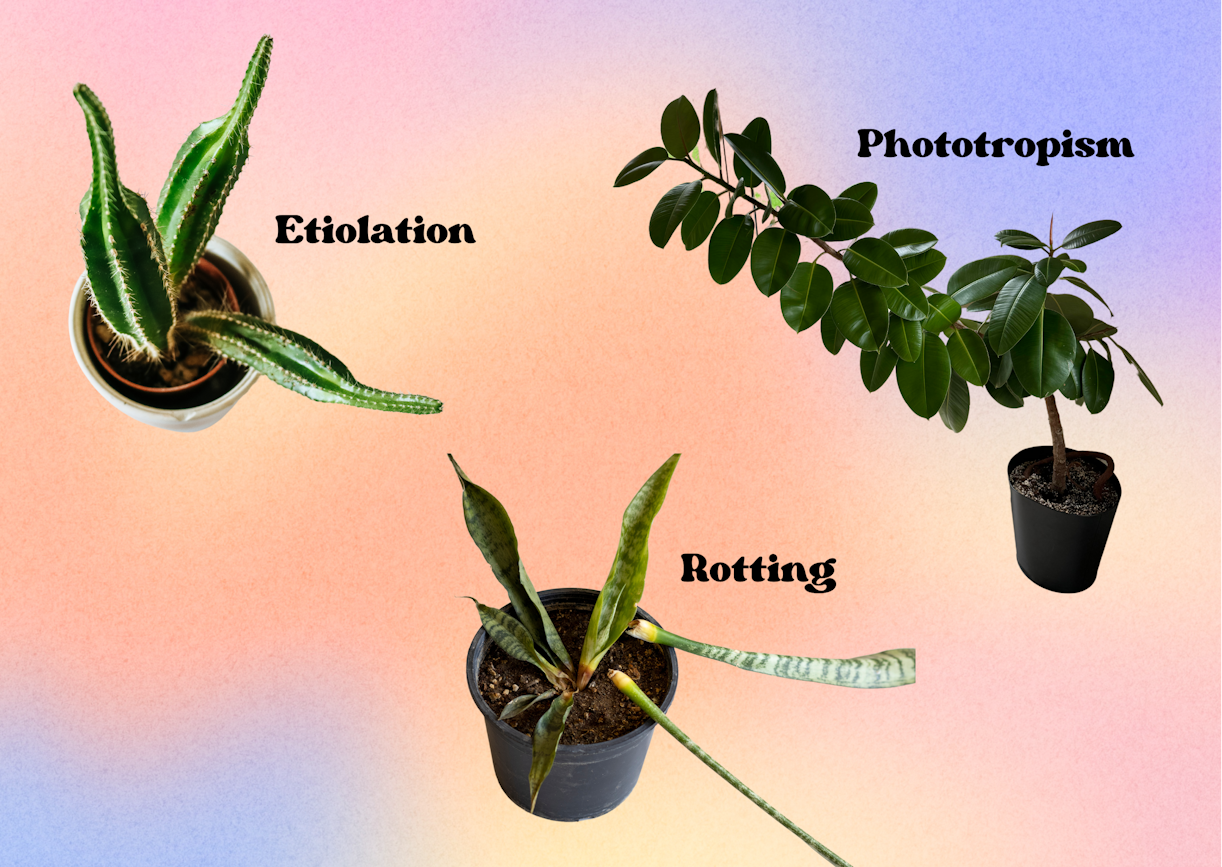
How do I know if my plant is getting too much light?
Unfortunately, there is no single solution for all plants, as for some plants, there can be such a thing as too much light. Signs that your plant is receiving too much light are:
- Quick decline: A plant with too much light’s leaves brown very quickly and curl up at the tips before dropping.
- Discolouration: The leaves go a light yellow colour until eventually fading to a crispy brown patch, usually round the margins of the leaf.
- Scorching: patches of singed brown/yellow patterns on the surface of the most prominent leaves, often largely aesthetic without any signs of leaf deterioration, but can quickly devolve into damage if not stopped early.
With this in mind, it is a good idea to organize your plants and where in your home they belong in respect of how much light they need. It's important to remember that different plants need different amounts of light, so it's always a good idea to ask what light conditions a plant needs before purchasing it! If you’re like me and far too impulsive and excitable to make a decision based on practicality, give the plant a little google upon returning home and see what you can do for it! Here is a little guide to what different light levels look like in your home:
How much light does my plant need?
Unfortunately, there is no ‘one size fits all’ plant, or light. The reality is that, in the wild, plants are exposed to different levels of light depending on where they grow geographically, where they grow specifically, what corresponding things exist around them and even what stage of growth they are in. Resultantly, not all plants have identical light preferences. Which makes the prospect of keeping plants under grow lights seem like a gargantuan task. In order to remedy this, I have compiled a list of popular houseplants, drawing from the table created by Darryl Cheng (https://www.houseplantjournal.com/bright-indirect-light-requirements-by-plant/) plus a few additions of my own, with information on the ideal light requirements for every one. The PPFD value attached is for the ideal growth conditions, most plants listed below can survive with less, but may not grow as desired. So now, all the information is in one place for you, and you can check back anytime you get a new plant, or even just to remind yourself for the ones you already have!
|
Plant |
Light Level |
PPFD (μmol) |
|
Aglaonema |
Medium |
80 μmol |
|
Alocasia |
Medium |
80 μmol |
|
Anthurium |
Medium |
80 μmol |
|
Araucaria |
Medium |
80 μmol |
|
Aspidistra |
Low |
40 μmol |
|
Begonia |
Medium |
80 μmol |
|
Bromeliads (Not including Tillandsia) |
Medium |
80 μmol |
|
Cactus (Epiphyte) (Epiphyllum/ Disocactus/ Rhipsalis/ Lepismium) |
Medium- High |
100 μmol |
|
Cactus (Terrestrial) (Echinocactus/ Myrtillocactus/ Cereus/ Opuntia) |
High |
160 μmol |
|
Calathea |
Medium |
80 μmol |
|
Ceropegia |
Medium |
80 μmol |
|
Chlorophytum |
Medium |
80 μmol |
|
Citrus |
Very High |
250 μmol |
|
Codiaeum |
High |
160 μmol |
|
Cordyline |
Medium |
80 μmol |
|
Crassula |
Medium |
80 μmol |
|
Curio |
Medium |
80 μmol |
|
Dieffenbachia |
Medium |
80 μmol |
|
Dracaena (not including syn. Sansiveria) |
Low- Medium |
60 μmol |
|
Dracaena (syn. Sansevieria) |
Low |
40 μmol |
|
Epipremnum |
Low |
40 μmol |
|
Ferns (Platycerium/ Asplenium/ Phlebodium/ Microsorum) |
Low |
40 μmol |
|
Ficus |
High |
160 μmol |
|
Fittonia |
Low |
40 μmol |
|
Hedera |
Medium |
80 μmol |
|
Holiday Cactus (Schlumbergera/ Rhipsalidopsis) |
Medium |
80 μmol |
|
Hoya |
Medium- High |
100 μmol |
|
Hypostes |
Medium |
80 μmol |
|
Indoor Palms (Chrysalidocarpus/ Dypsis/ Howea/ Chamaedorea) |
Medium |
80 μmol |
|
Maranta |
Low |
40 μmol |
|
Monstera |
Medium |
80 μmol |
|
Orchids (Epiphyte) (Phalaenopsis/ Dendrobium/ Brassia/ Paphiopedilum /Cymbidium) |
Medium- High |
100 μmol |
|
Orchids (Terrestrial) (Ludisia/ Anoechticillus/ Goodyera/ Dossinnia) |
Medium |
80 μmol |
|
Oxalis |
Medium |
80 μmol |
|
Pachira |
Medium |
80 μmol |
|
Peperomia |
Low |
40 μmol |
|
Philodendron (Climbing) |
Low |
40 μmol |
|
Philodendron/ Thamatophyllum |
Medium |
80 μmol |
|
Pilea |
Medium |
80 μmol |
|
Plectranthus (Coleus) |
Medium |
80 μmol |
|
Schefflera (Heptapleurum) |
Low |
40 μmol |
|
Scindapsus |
Low |
40 μmol |
|
Spathiphyllum |
Low |
40 μmol |
|
Strelitzia |
High |
160 μmol |
|
Streptocarpus (African Violets) |
Low |
40 μmol |
|
Succulents (Echeveria/ Aloe/ Aeonium) |
Medium |
80 μmol |
|
Syngonium |
Medium |
80 μmol |
|
Tillandsia |
Medium |
80 μmol |
|
Tradescantia |
Medium |
80 μmol |
|
Yucca |
High |
160 μmol |
|
Zamioculcas |
Low |
40 μmol |
It's important to note that for many plants, there are various factors that affect light tolerance. Plants in the Araceae family (Monstera, Philodendron, Epipremnum, Scindapsus, Zamioculcas, Syngonium, Spathiphyllum, Anthurium, Alocasia) can tolerate more light as they get larger: a evolutionary trait that benefits them in the wild. Certain plants, like Hoya and Orchids, require large amounts of light to bloom, but can grow foliage happily in lower light conditions. Further, high quality plant food that provides a good balance of essential nutrients (potassium, phosphates, nitrates) helps to keep a plant strong and able to tolerate more light.
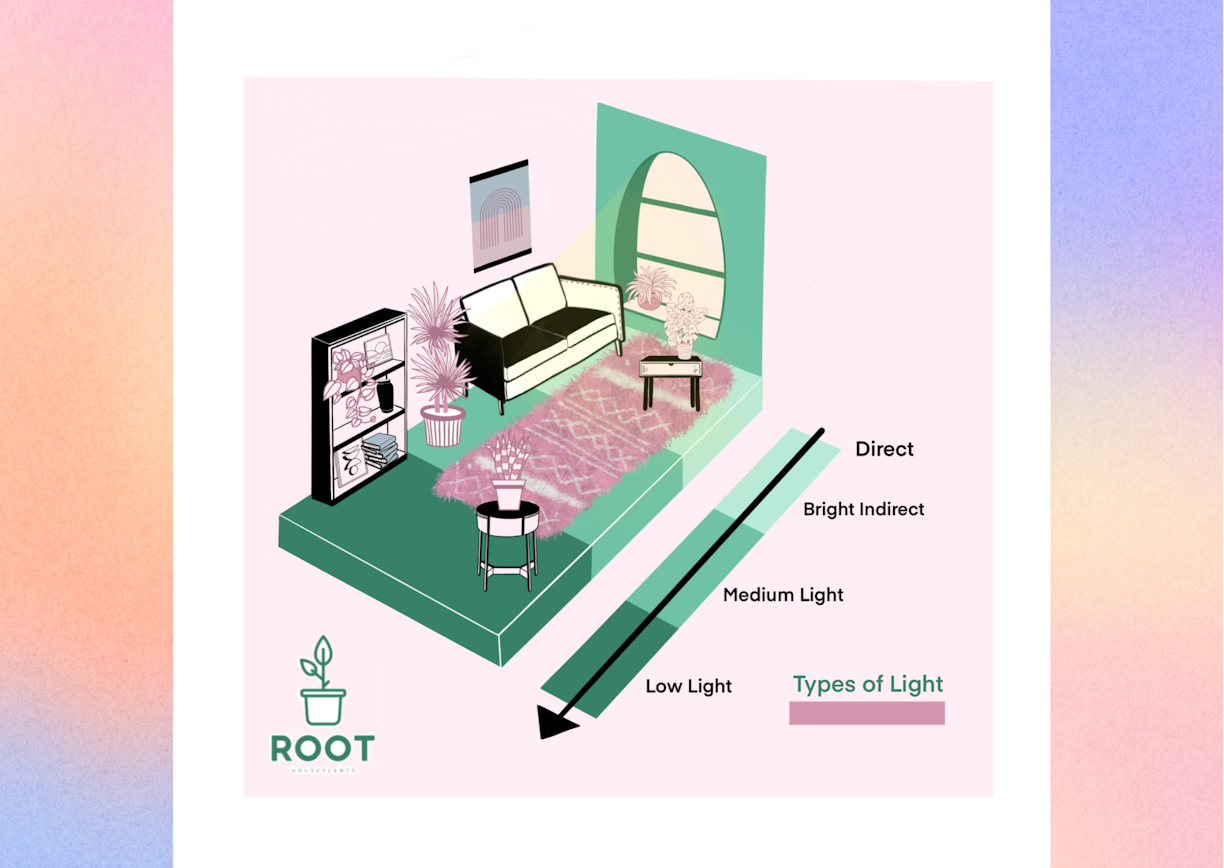
Are grow lights useful to me?
In some places, a lack of natural light is unavoidable, and even with windows there can be no viable plant-space around them, and all spaces where a plant would fit seem to be in the least conveniently lit spots. This is frustrating, but if your love of that which grows cannot be slowed by a lack of practical means, then grow lights are certainly for you! They have a number of uses, including lighting up spaces that have no natural light at all, supplementing light in spaces with less than adequate sunlight, reinforcing types of light that encourage certain seedlings to germinate and older plants to grow foliage or bloom. Depending on the size and wattage of the light, they can be used on multiple plants or a single plant.
If you understand what types of light a plant needs, it is easier to make sense of what type of grow light you need! Light as we know it is a combination of multiple colours on a spectrum. The sun emits a full spectrum of coloured light onto the earth. Of this full spectrum, plants utilise three most of all:
- Red: Aids the production of flowers and fruit, as well as helps seeds and seedlings germinate and promotes root growth & reproduction.
- Blue: Helps with the production of chlorophyll which makes for better stomatal opening, more productive photosynthesis and foliage growth.
- Green: Previously believed to be completely reflected and not useful to plants, but now is understood to aid photosynthesis by stimulating non-chlorophyll photoreceptors.
Of these three colours of light, red and blue are certainly the most important. Contrary to popular belief, the UltraViolet spectrum of light emitted from the sun is not essential for plants, but does aid in the production of protective compounds. Likewise, Infrared Light is useful to stimulate biomass production and can help promote stem growth and flowering. Considering all of this, it certainly seems most beneficial to provide a full spectrum of light for the best results.
What to look for in a grow light:
There are a large number of grow lights out there, and sometimes searching for the right one can be difficult and overwhelming. The most important things to look for are lights that suit you, and what you are using them for. Resultantly, these are the things you should check for when grow-light shopping:
- Colour: Grow lights come in many colours, it is important that you aim for one that provides your plant with what you want to give it. A red grow light helps with fruit and flower production and is good for crops such as tomatoes and citrus and prolific bloomers like orchids and hoya. A blue light primates strong healthy leaf growth and is good for heavily foliating plants like aroids (Monstera, Philodendron, Scindapsus etc.) and plants with large, green areas (Cacti, Euphorbia, Succulents). An ideal grow light uses at least both of these colours, and some even allow you to choose whether you want to use red light, blue light or both. It is for this reason that a lot of grow lights are purple/violet or a brilliant white if they include green light too. The most ideal spectrum for a grow light provides all wavelengths of light and includes the UV and IR spectrums too. These are labelled as ‘full spectrum’.
- Not Halogen or Incandescent: While halogen and incandescent bulbs do provide a full spectrum of light, they provide a lot less that their LED counterparts, and for much greater a cost both financially and to the health of the plant. These types of bulbs emit large amounts of heat, which simultaneously waste energy and increase the risk of scorching your plants at the same time.
- Efficiency: Because of the nature of grow lights, and their use as a tool to replace sunlight in many cases, they are likely to be left on for significant portions of the day, as a result they will consume a lot of energy if they are not energy efficient lights, which has bad results for the planet, and for your household bills too! LED’s are the best solution, as energy efficient bulbs that do not generate much heat.
- Wattage: The wattage of a bulb will tell you how productive it will be for growing plants. The higher the wattage, the stronger the light will be, so for a high wattage light it is recommended that it shines on plants from a reasonable distance. For low wattage, perhaps on a single plant from fairly close.
- PPFD: PPFD is ‘Photosynthetic Photon Flux Density’. This is a method of measuring the amount of photosynthetically active photons per second emitted by the light. This is different depending on how far the light is from the plant. The flux density is higher for more powerful lights and lower for less powerful lights, which should be taken into account based on what plants you are growing:- Low Light: >80 - Medium Light: 80-150- High Light: 150-350- Very High Light: 350-600- Direct Light: 600+
How long should I leave my grow lights on?
The energy cost is a big decision influencer for people at the moment, and rightly so. The most common thought is that having a grow light on all day could seriously affect their bills each month. Grow lights can be managed to only supplement light during the most important or productive period of the day, and such is actually recommended.
Plants only really photosynthesize for 6 hours when young and a maximum of 10 hours for mature plants. Therefore, a grow light complimenting this is ideal for most productive growth. For lights that are supplementary to natural light, this can be reduced even further, as the presence of lower light levels from the sun in the morning and evening aptly mimics the rising of the setting of the sun. A lot of grow lights come equipped with built-in timers to help those of us who are busy or forgetful! If not, plug in timers are affordable and accessible, usually from the companies that provide the grow lights themselves!
Finally, it's important to note that photosynthesis is not the only active process in plant productivity. There are multiple things happening in a plant that allow for growth, and resultantly, leaving a grow light on a plant for 24 hours a day is unfortunately not a method of producing a bigger plant. A plant needs the respirate during the night time, when its stomatal openings shut. It uses light levels to detect when to do this. A day/night cycle is not just recommended, it is crucial to a plant's survival. Forgetting to turn your grow lights off for one night would not destroy your entire collection, but doing it repeatedly may start to confuse the plant and have a significant negative impact long-term.
What is the right product for me?
There are lots of growth technology products out there, and none of them are particularly negatable. Each serves a different purpose. Hopefully, by use of the information provided in this post, and understanding of the plant you wish to grow, you can find the right product for you! Below is a list of some of the most popular grow lights on the market. A few of them do not operate as an independent supplier and work with various e-commerce sites such as Amazon or Ebay, but they are often the most frequently purchased option due to this. Included is a brief description of the product, an energy rating and their general price in comparison to others.
The list below also provides the PPFD (Photosynthetic Photon Flux Density) value of the product, which is a method of measuring the amount of photosynthetically active photons per second emitted by the light. This is different depending on how far the light is from the plant, so for the examples below we are working as if the light is approximately 30 cm from the plant. Generally, the higher the number the more powerful the grow light. It’s important to note that if your grow lights are being used alongside natural light, then this will provide a portion of the necessary PPFD too, and a lower value should be considered.
Hopefully the following list will give you some insight into what the right product is for you.
Price: ££
PPFD: 33.1 μmol/s
Energy Rating: A
Description: An energy efficient bulb that can be screwed into any traditional light fitting or bulb holder. It provides an 18W LED light with a beam angle of 60 degrees meaning it can be used on a multitude of plants at once. It uses plant-focused wavelengths of light, utilizing the most productive colours of light to maximize its PPFD and provide the plant with lots of light for photosynthesis and growth.
Barrina T5
Price: £££
PPFD: 59.3 μmol/s
Energy Rating: C
Description: Barrina T5 is eight, 2ft LED strip lights that collectively provide 80W from a 120 angle, full-spectrum light that can be divided proportionately between several plants. It uses a full spectrum of light helping to optimize growth in plants of all stages of life and blooming in mature plants.
Price: £££
PPFD: 136 μmol/s
Energy Rating: ???
Description: The Monios T8 grow lights contain 6 LED strip lights of 42W each that can be divided between a number of plants to cover large spaces. They give off a full spectrum of coloured light to provide good conditions for the promotion of growing and blooming. The energy rating has been difficult to find, but given the specifications it is likely similar to the Barrina T5 above. They do not have their own supply website and can be purchased through e-commerce sites such as Ebay and Amazon.
Price: ££££
PPFD: 250 μmol/s
Energy Rating: ???
Description: Spider Farmer generally aim their products at large scale growers, and this is their smallest, most affordable product. It is a flat, hanging, 100W LED light that covers a small area and provides a full spectrum of coloured light. Although the energy rating is unidentified, they claim to provide the productivity of 200W lights at only 100W, using half the heat and electricity to produce these results, which is a very positive claim and vouches for the energy efficiency of the product despite the lack of any official rating.
Price: £
PPFD: ???
Energy Rating: ???
Description: This product and its supplier has been included in this list due to its position as one of the best selling growth technology products on Amazon. The product itself is a clip that connects to four steel gooseneck arms each of which has a tube of led lights that can reach an area of 70cm. The product provides a built in auto timer and a selection of 10 different brightness levels, as well as a selection of red light, blue light or ‘mixed light’. While the product is affordable and convenient, the lack of energy rating, PPFD and Wattage makes it difficult to evaluate. Based on personal experience and reviews, it seems a useful product for single plants, but is not nearly to the power or provision of the above lights, that are purpose designed for maximum potential. Even the ‘full spectrum’ it is labelled with refers to a few single diodes within the strip and these are certainly not as bright or effective as other full spectrum options. The benefit to this product is definitely in the built in timer and adjustable brightness, but the lack of specifications brings hesitation.
Lumatek 100W Full-Spectrum Supplemental Light
Price: £££££
PPFD: 295 μmol/s
Energy Rating: ???
Description: This is a full spectrum + tube light that encases full spectrum LEDs operating at a power of 100W, while providing a really high PPFD, which despite the lack of any official energy rating, generally suggests high efficiency. The light can be dimmed with accompanying products, boasts a 120 degree beam angle and is waterproof, allowing for easy cleaning. The company is certainly aimed at large scale growers, but this smaller product is their cheaper and more accessible light, and is good to cover a fairly large area of plants for the hobbyist without being a huge investment. This light is ideal for germinating seedlings, promoting foliage growth and influencing blooming. It is certainly best for high light plants, but for anything less, or for those that still access a proportion of sunlight it is probably an overcompensation.
Price: £££
PPFD: ???
Energy Rating: A
Description: This is a 600W, hanging, flat grow light that uses 566pcs of various colours of LED lights to provide a full spectrum of light, prioritising those which aid in photosynthesis. The reviews for this product are generally great, and all purchases come with a 2 year guarantee, so if the product is faulty it can be reimbursed or replaced. FECiDA do not provide details as to what the PPFD is specifically but claim it has a ‘high PPFD’. Based on the wattage and the spectrum provided it is likely quite a powerful lamp.
Price: £££
PPFD: 340 μmol/s
Energy Rating: A
Description: This is a screw in bulb designed to be attached to a standard light fitting to turn it into a grow light. Although the product boasts a really high PPFD, it works over a short area, meaning that this power is only really intensified within a 1ftx1ft space. This is amendable by choice however, as the manufacturers produce both a 36 degree version and a 60 degree version for the same price. This makes it a really good grow light for high to very-high light plants such as hoya and cacti. The bulb itself is a 20W LED, which is a great energy saver, and produces a full spectrum of light, highlighting an efficient combination of photosynthetic wavelengths.
It is worth noting that there are significantly more products on the market of equal quality. The above are specific models from specific companies, but those companies sell multiple models designed for different purposes. I recommend that, if you are looking for a grow light, browse their collections and see what suits you. Read the specifications and see which matches the plant you’re looking to help the most! The above list is a guide to the most popular or affordable from reputable companies, and in my opinion is a great place to start.
Grow lights are certainly the solution to growing in a home with minimal window space, or lower levels of light. It’s wonderful that in the modern day, with the right tools, plants really can thrive in any environment!
References
- Chalker B.E., Dunlap W.C., Oliver J.K., (1983). Bathymetric adaptations of reef building corals at Davies Reef, Great Barrier Reef, Australia. II. Light saturation curves for photosynthesis and respiration. J Exp Mar Biol Ecol 73: pp. 37–87.
- Gorton, H.L. (2010). "Biological Action Spectra". Photobiological Sciences Online. American Society for Photobiology.
- Massa, G. D., Kim, H., Wheeler, R. M., and Mitchell, C. A. (2008). Plant Productivity in Response to LED Lighting. HortScience horts, 43 (7), pp. 1951-1956 https://doi.org/10.21273/HORTSCI.43.7.1951>
- McCree, K.J (1971) The action spectrum, absorptance and quantum yield of photosynthesis in crop plants, Agricultural Meteorology, 9, pp.191-216. https://doi.org/10.1016/0002-1571(71)90022-7
- Pocock, T. (2015). Light-emitting Diodes and the Modulation of Specialty Crops: Light Sensing and Signaling Networks in Plants. HortScience horts, 50 (9), pp. 1281-1284. https://doi.org/10.21273/HORTSCI.50.9.1281
- Raven, P.H; Evert, R.F; Eichhorn, S.E. (2005). Biology of Plants (7th ed.). New York: W. H. Freeman and Company. pp. 124–127.
Jonathan Davies
Jonny has worked at Root since May 2023. His love for plants was inherited initially from his grandparents and parents, but really took off once he moved into his own place, where he started picking up small plants and was fascinated by watching how they grow and change over time. Jonny has a degree in Archaeology and Classics from the University of Sheffield, and a masters in Egyptology from Swansea University, where he primarily focused on garden culture in the ancient world, which he has managed to extend to a PhD thesis in the University of Liverpool, where he has been able to combine his love for plants with his love for ancient language and culture. Jonny loves being in the natural spaces around North Wales and Cheshire where he used to go growing up, and often spends hours examining the plants and trees, and kicking up the leaf litter searching for mushrooms and insects. He is fascinated most by plant biology, taxonomy and learning about ecosystems and interactions between plants and their environmental counterparts, and enjoys tending to his varied array of houseplants, and ongoing ‘plant projects’, such as growing plants from seeds and creating living epiphyte displays. Aside from his green thumb, his other interests include: art, reading, listening to and playing music in the company of his cats, Spooky and Boo.
More by Jonathan DaviesRelated Articles
View all articles
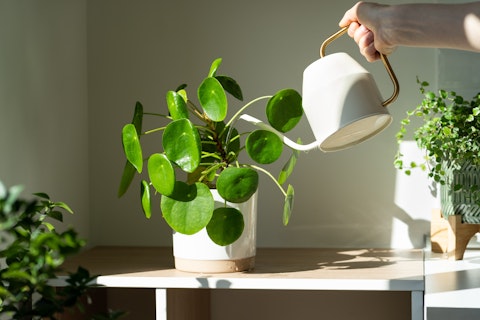
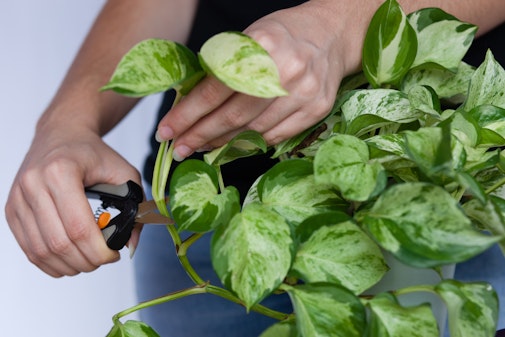
General Houseplant Care
Propagating Plants - Making new plants from the ones you have already
By Jonathan Davies
